
© Tristram Kenton. (Click image for larger version)
Royal Ballet School
Playfully So, Don Quixote excerpt, Garland Dance from Sleeping Beauty, Swingle Stepping, Mephisto Waltz, Elite Syncopations, Mozart Suite, Is to be, Grand Défilé + film of life at White Lodge Lower School
★★★★✰
London, Royal Opera House
10 July 2021, matinee
www.royalballetschool.org.uk
www.roh.org.uk
Christopher Powney, the Royal Ballet School’s Artistic Director, dedicated this year’s matinee performance to the students and staff as a tribute to their resilience and creativity throughout a very difficult time. Last year’s summer performances were cancelled, and the students were unable to return to studio classes until March this year. Powney and his staff, determined to get them on stage in front of an audience before the academic year was over, managed to assemble nine different programmes with over 32 performances in various venues. Because of Covid restrictions, the final matinee on the Royal Opera House stage could not include the youngest pupils from the White Lodge Lower School. Their appearance had to be virtual in the concluding Grand Défilé, projected on film while the older students lined up on stage in costumes colour-coded by year of training.
The BalletBoyz, Michael Nunn and William Trevitt, had filmed the White Lodgers back at school, delightfully introduced by a pupil from each year’s class. They range in age from 11-16; the Upper School in Covent Garden is for 16-19 year olds. (Trevitt’s son Elijah is one of the 3rd year graduates, with a contract from The Australian Ballet.) A glimpse at the start of the film of the youngsters at home on their practice mats, taking class by Zoom, was a reminder of how unusual lockdown has been for dancers of all ages.
A video, made by the RBS in July 2020, of how the school coped during lockdown
The matinee programme featured the three years of the Upper School and final year 11 of White Lodge in works that used large numbers of performers. The exception was a solo from Don Quixote Act III, danced by 3rd year Yuma Matsuura, who had won the Youth America Grand Prix with it in 2018, when he was just 15. He chose to finish his training at the RB School, and is about join the American Ballet Theatre Studio Company. A virtuoso performer, he reappeared later in the programme in ensemble works.

© Tristram Kenton. (Click image for larger version)
It opened with Valentino Zucchetti’s Playfully So, to Prokofiev’s Symphony no 1 in D major, (also used by Liam Scarlett for an RBS creation in 2014). The 2nd year dancers appear to be playground youngsters in outfits designed by Zuchetti and Suzie Holland. The work is a frolic for flying figures, with references to Jerome Robbins, Scarlett and Frederick Ashton – there’s even a Fred step. Girls line up crossing their hands like Swan Lake’s cygnets; boisterous boys parade to the Gavotte that Prokofiev recycled for his Romeo and Juliet ballet score. Couples form a frieze behind a pas de deux pair, as they do in Zucchetti’s Anemoi for the Royal Ballet. Twice, naughty couples dash into the wings together, hoping they won’t be spotted by the others. Prokofiev called his first symphony ‘lively and blithe’, and so is Zucchetti’s playful ballet.

© Tristram Kenton. (Click image for larger version)
Next came Upper School 1st years in the Garland Dance from Peter Wright’s production of The Sleeping Beauty for Birmingham Royal Ballet. They had to show how they could be corps de ballet members in a formal set piece, waltzing in line with each other and not fumbling their garland props: no place here for self-expression.
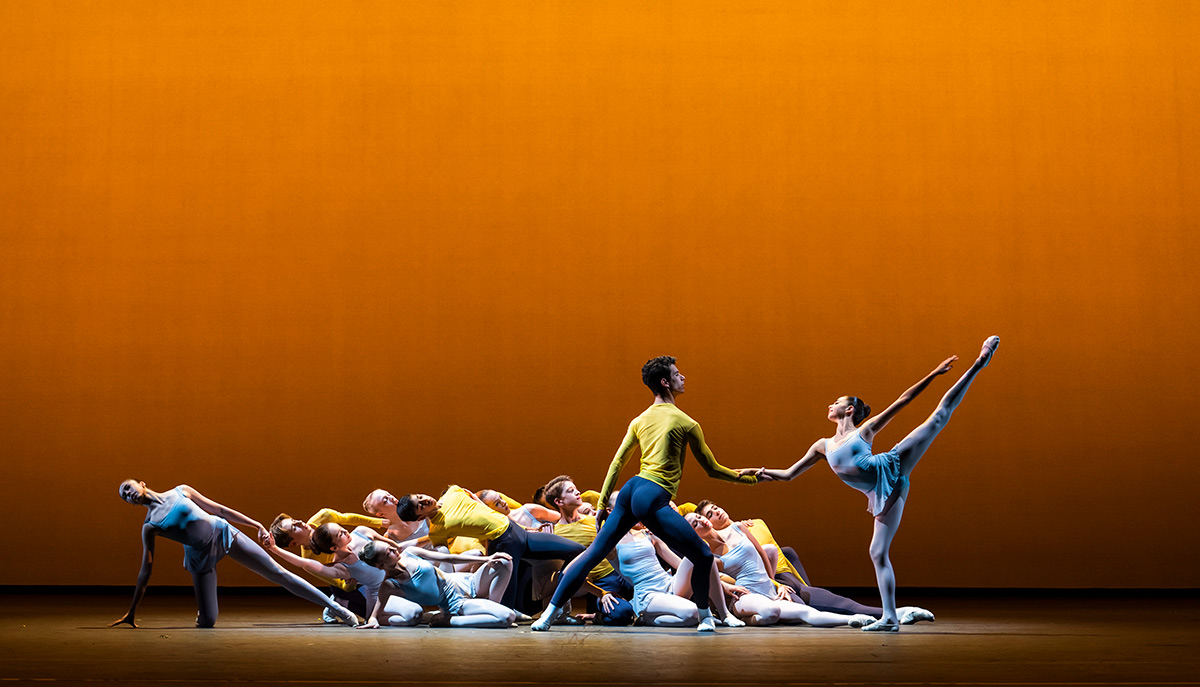
© Tristram Kenton. (Click image for larger version)
Morgann Runacre-Temple combined all 30 youngsters from White Lodge year 11 in Swingle Stepping, a sequence of dances to an eclectic choice of music: Henry Mancini’s theme for the Peter Gunn TV series (1959 on), as well as music by the Swingle Singers, The Blue Brothers and a tribute to JS Bach’s Ode to Joy. She starts with just a few dancers, then adds in more and more, setting them moving in counterpoint and canon; they pile together in a tangle of elbows and knees or organise themselves into a group tableau framing a single individual. Sometimes a girl or boy would be isolated from the others – outsiders who are then incorporated into the ensemble. Sometimes there’s an awkward adolescent encounter between two individuals who did or didn’t want to pair up. Swingle Stepping comes across as a very human rite of passage for a close-knit class of young dancers about to move on to the next stage of their lives.

© Tristram Kenton. (Click image for larger version)
Upper School graduates from year 3 will be dispersing to different companies: all 25 have contracts, with four joining the Royal Ballet’s Aud Jebsen Young Dancers Programme. Ashley Page created Mephisto Waltz for ten of them, the women in sophisticated dark purple tutus borrowed from Scottish Ballet, Page’s former company (2002-2012). He choreographed Strauss waltzes for the Vienna State Ballet’s contribution to Vienna’s New Year Concert in 2014, so he’s adept at devising waltz variations that require dancers to swirl lavishly in intimate partnerships – a challenge valiantly met by five relatively inexperienced couples.
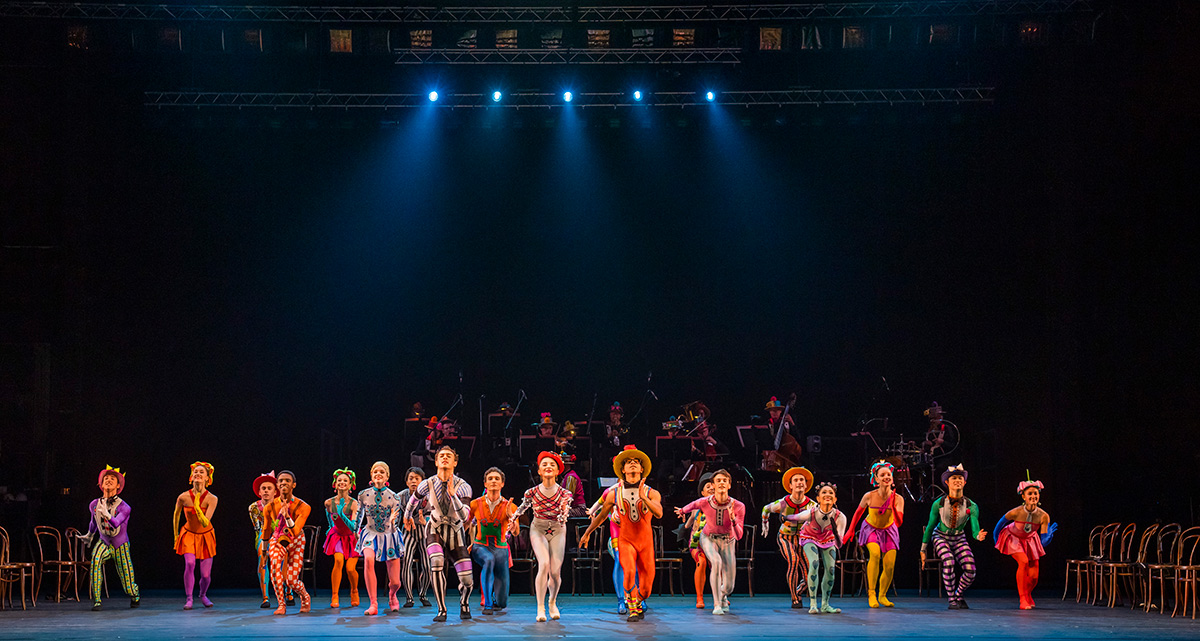
© Tristram Kenton. (Click image for larger version)
The middle section of the programme was taken by Kenneth MacMillan’s Elite Syncopations to ragtime music by Scott Joplin (and others). When the Royal Ballet returned briefly to live performances near the end of last year, the number of dancers in Elite Syncopations was doubled in order to get as many performers on stage as possible. This time, numbers were reduced because of Covid restrictions. MacMillan’s ballet is an odd choice for students, even 3rd year graduates, since its seeming insouciance disguises references to the dance marathons of the Depression years in America, when desperate couples kept going to win money (as in the film They Shoot Horses, Don’t They?).
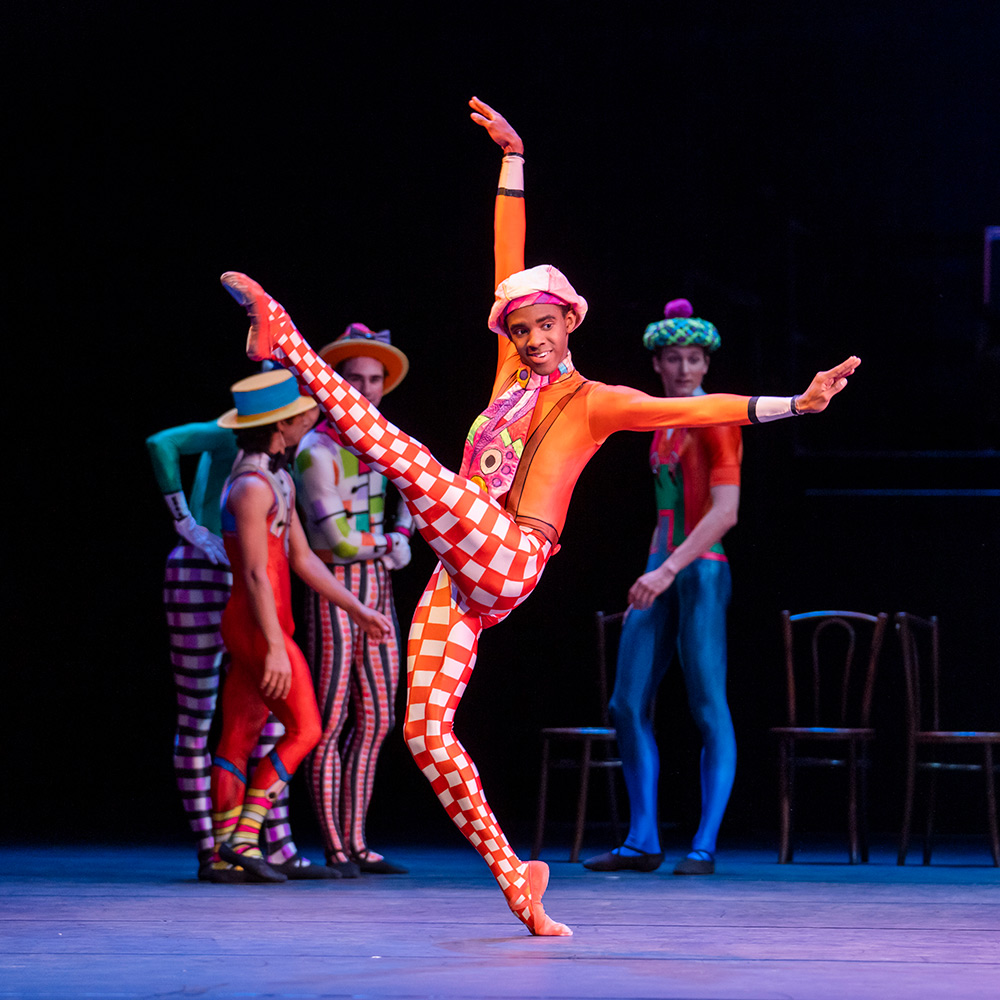
© Tristram Kenton. (Click image for larger version)
The solos, cynically knowing, are better suited to more mature performers, as is the pas de deux to the Bethena waltz for a siren and her escort (Viola Pantuso and Raffaello Barbieri). The charming duet to The Golden Hours for a shy couple was endearingly danced by Rimi Nakano and Elijah Trevitt. The Alaskan Rag duet for a tall woman (Tara Millard) and a much shorter man (Amiruddin Shah) is problematic. Its comic timing is very tricky, and in order for us not to feel sorry for the man, we have to be certain of the woman’s affection for him. I wish Shah, who has a contract with the Joffrey Studio Company, could have had a more dignified role to show off his talent. That said, the 3rd years accomplished the ballet with audacity, enabling us to enjoy the gaiety of its syncopated rhythms, played by the onstage ragtime band, led by Robert Clark on the piano.
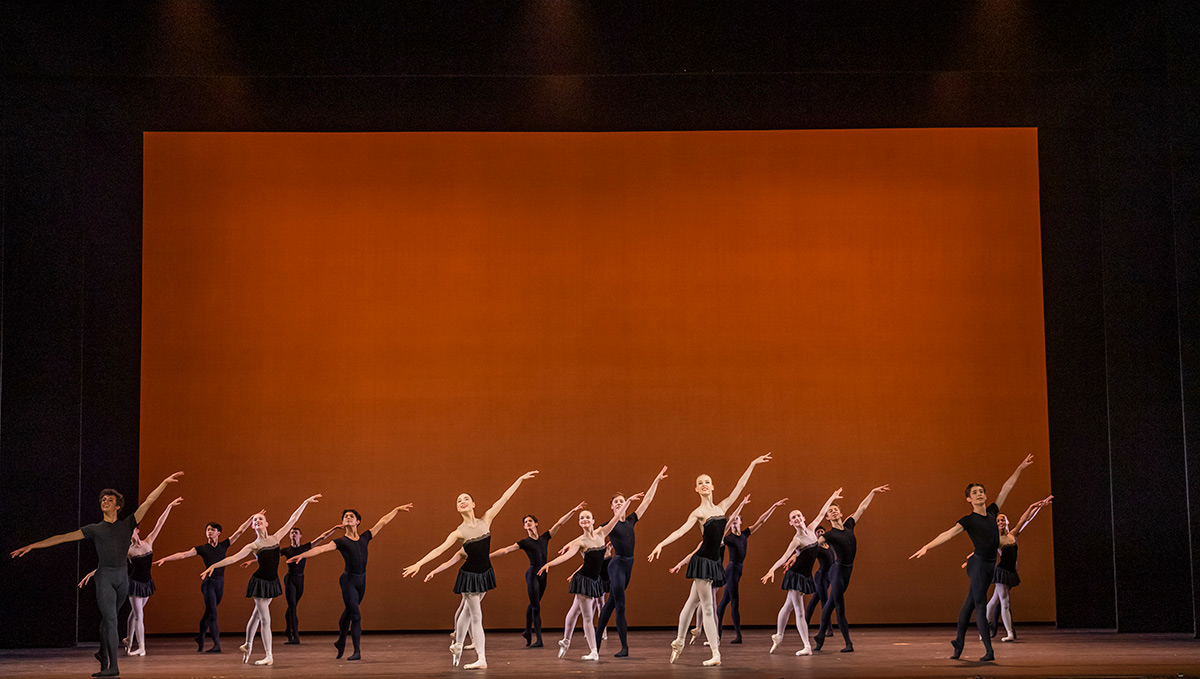
© Tristram Kenton. (Click image for larger version)
After a second interval came Mikaela Polley’s Mozart Suite, to the Presto finale of his Sinfonia Concertante in E-flat major. Twenty Upper School 1st years in black tunics executed Polley’s swift choreography with its emphasis on elegant lower leg work rather than high extensions, though the men did get to show off the height of their jumps. The dancers acknowledged the audience, performing for us rather than each other, in contrast to the next work, Didy Veldman’s contemporary dance creation, Is to be, for 2nd year students
Choreographed originally for the 2019 Prix de Lausanne, it involves 26 dancers in vests and shorts moving en masse to the first movement of Arvo Pårt’s Tabula Rasa. There’s a recurring motif of inward-facing circles and huddles, alternating with line-ups for girls and boys. After a lot of repetitive running and swaying to Pårt’s surging music for strings, couples and soloists break away briefly before being reabsorbed. Structure and choreography are simple but effective for large numbers – a useful training for dancers who might later perform non-balletic choreography by Crystal Pite or Hofesh Schechter.
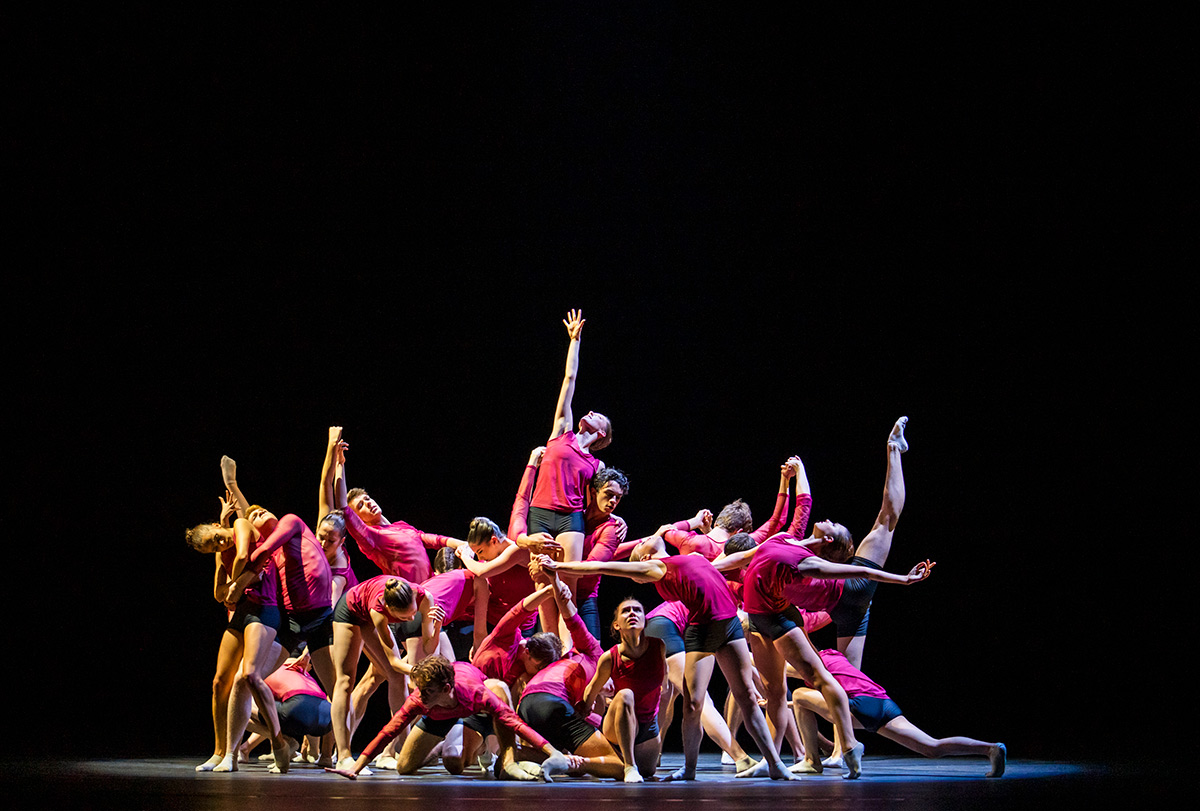
© Tristram Kenton. (Click image for larger version)
Back to conventional classical ballet for the penultimate pas de deux, the first movement of Ben Stevenson’s Three Preludes to Rachmaninoff’s Prelude in B minor, op 32, no 10. It involves a man, a woman and a ballet barre and was splendidly danced by 3rd years Julia Petanova and Alejandro Valera Outlaw. (She joins Norwegian National Ballet 2, he goes to American Ballet Theatre Studio Company.)
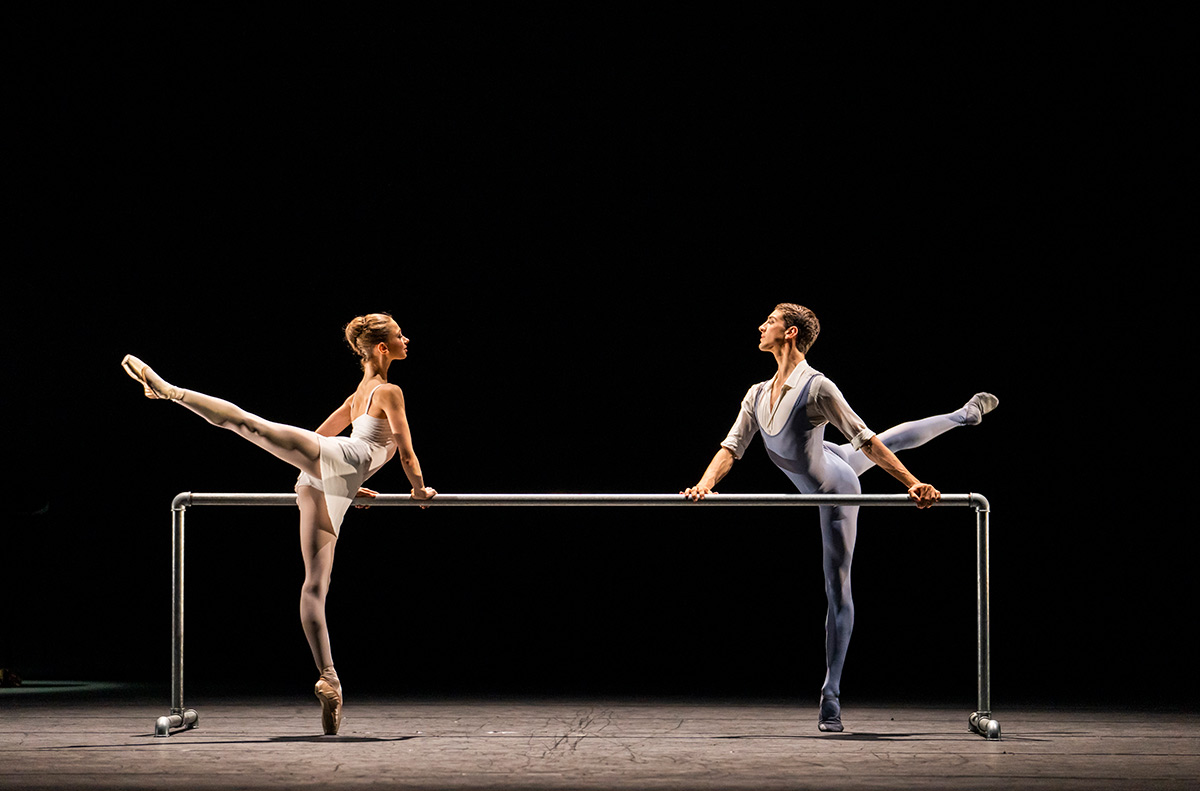
© Tristram Kenton. (Click image for larger version)
They were followed by the White Lodge film, charmingly introduced by Dame Darcey Bussell, and then the abbreviated Grand Défilé, accompanied by applause, youthful screams of appreciation and tears on and off stage. Though these students are training to be artists as well as athletes, the ethos the matinee conveyed was much the same as that of England’s football team: dedication, teamwork, discipline and hard work. And learning to cope with setbacks as well as success in the rest of their careers.













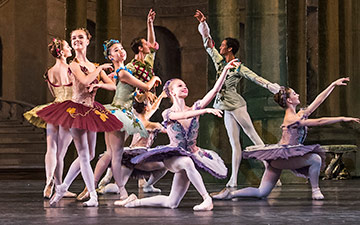
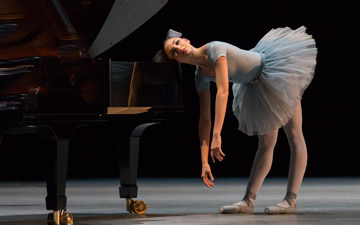


We incorrectly stated that Julia Petanova is joining the RB Aud Jebsen Young Dancers Programme and this is now corrected – Petanova is actually joining Norwegian National Ballet 2. Apologies to all.